8+ Sample Training Needs Assessment Survey
-

Training Needs Assessment Survey Report Template
download now -
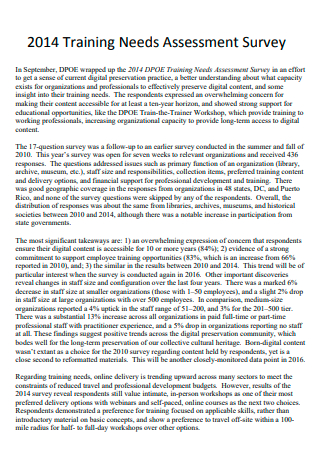
Basic Training Needs Assessment Survey
download now -
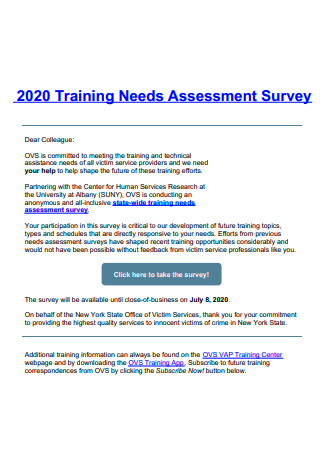
Training Needs Assessment Survey Example
download now -

Management Training Needs Assessment Survey Questionnaire
download now -
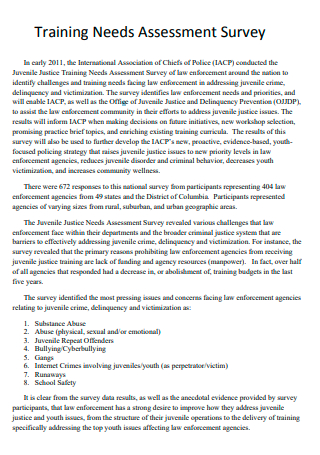
Training Needs Assessment Survey in PDF
download now -

IT Training Needs Assessment Survey
download now -
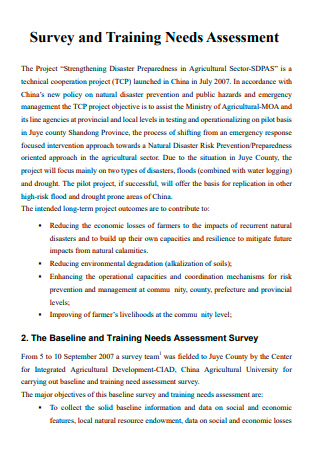
Printable Training Needs Assessment Survey
download now -
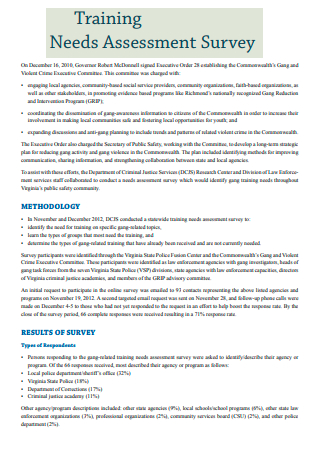
Standard Training Needs Assessment Survey
download now -
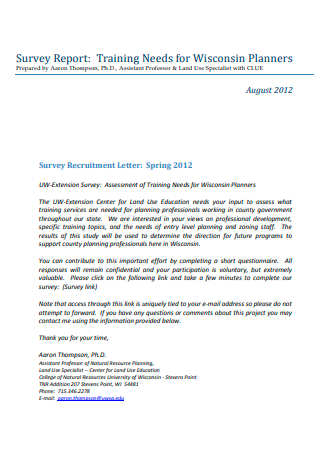
Training Needs Assessment For Planner Survey Report
download now
FREE Training Needs Assessment Survey s to Download
8+ Sample Training Needs Assessment Survey
What Is a Training Needs Assessment Survey?
Benefits of Training Needs Assessment
Tips for Conducting Effective Training
How to Conduct a Training Needs Assessment
FAQs
What are needs assessment tools?
What are the training and development requirements?
What is effective training?
What Is a Training Needs Assessment Survey?
Evaluation of training needs is one of the most effective methods for addressing competency gaps. It can be undertaken at any moment, including during hiring, creating career development plans, performance reviews, succession planning, and the management of job-related changes. Training needs assessment surveys and training needs assessment reports should be conducted regularly using a training needs assessment form and training needs assessment questions to determine if there is a need for training and if the organization’s existing training programs are effective. According to statistics, businesses that spend on staff training have a 24% larger profit margin than those that do not.
Benefits of Training Needs Assessment
As with any process, a firm foundation is essential for success. A training needs assessment establishes the framework for evaluating your organization’s genuine training needs and the most effective way for your staff to acquire the necessary training. In this section, we shall explain its merits and how they can benefit businesses at present.
Tips for Conducting Effective Training
Did you know there are tried-and-true methods for making your training more successful and engaging? And did you know that these strategies are relevant to all of your audiences, including customers, partners, and employees? If you’re still interested, here are some suggestions for training your personnel effectively.
1. Select your format with care: opt for video
We already understand that video increases retention. Video is the most engaging media since it engages most of our senses during the learning experience. Using real individuals to present the movies can make them more personable while remaining scalable. Due to the variety of available formats (role-playing, screen-casting, voiceovers, animation, etc.), you may adjust your content to different learning objectives and successfully express distinct concepts.
2. Encourage interactions
You should select activities that encourage interaction, one of the pillars of an engaging and memorable educational experience. It is possible to add quizzes, survey reports, questions and answers, challenges, and assessments before, during, and after the course. These exercises will aid employees in recalling newly gained information and applying it to specific scenarios. Moreover, interactions promote engagement and retention and contribute to success measurement.
3. Note-taking and real-life transition
Ensure that your employees can effortlessly take notes, preferably within the same learning environment, and save them for future perusal. Taking notes improves concentration, encourages active learning, and enhances comprehension and retention, thereby assisting students in memorization. In addition, you should encourage your students to apply what they have learned and consider real-world scenarios in which they might use their knowledge. Your challenges can inspire students to focus on the practical application of the learning information, such as: “What will you change in your everyday routines based on what you have learned today?”
4. Be explicit and direct
Aim for communication that can’t be misunderstood; you must ensure there is no doubt about what you are saying. This means, for example, that you have to explain what each term means if you use technical jargon. Also, remember to cut out anything that isn’t necessary. It’s better to be short and to the point. If you need to add more details or a deeper level of content, you can add it as an attachment. Don’t give too much information or let it get in the way of what you want to say.
5. Start and end well
Like other presentations, a warm welcome and a strong beginning will get your audience’s attention. You can start by asking questions, creating a “what if” scenario, or giving some interesting facts. The most important thing is that your presenter be friendly and full of energy. Everyone in the crowd should feel like the speaker is talking directly to them. In the same way, a good wrap-up is essential to end things on a high note. It’s necessary to make a list of the most important things to remember and keep coming back to the training goals and benefits for the learners.
6. Measure, analyze, and enhance technology
You should seek a training platform that provides an accessible and engaging learning environment. If users are annoyed by their login credentials or the general usability of the platform, their capacity to learn will suffer. Frustration and tension will diminish the effectiveness of your training. In addition, you must have a clear understanding of your learning objectives and business objectives to monitor your progress and validate your activities. Only by measuring your results can you continue to improve. It is essential to evaluate what works continuously and doesn’t to constantly improve your content and training.
How to Conduct a Training Needs Assessment
Evaluation of training needs is one of the most effective methods for addressing competency gaps. It can be undertaken at any moment, including during hiring, performance reviews, and the management of job-related changes. If you’re still interested, here are many training needs assessment steps:
Step 1: Identifying the Business’s Needs
The first step of a training needs assessment is figuring out your business needs. It will help you figure out where you need to focus on closing the gaps in your skills. Learn about the department and the organization’s overall goals so you can evaluate and find the training opportunities that will help the organization as a whole succeed. The assessment will also help determine what needs to be done to motivate employees by giving them chances to move up in their jobs and using the organization’s training options. At this point, it’s essential to answer questions like whether or not the organization needs this assessment, why it’s doing it, what the end goal is, and whether or not training will help the organization reach its goal. It’s important to know if needs assessment is the best way to solve the problems at hand or if another method, like employee management, job analysis, etc., will work better.
Step 2: Determine Priorities and Causes
The organization has identified the need for training, and it is now time to evaluate them and decide whether or not they are genuine and warrant addressing. If you seek techniques to conduct a compelling needs assessment, you should rank them by importance. This will aid in the identification of low-priority needs that can be met through alternative cost-effective means. Additionally, if you seek techniques to conduct a successful needs assessment, you should identify issue areas. Know and comprehend the performance requirements and the necessary solutions.
Step 3: Conduct a Gap Analysis
If you wish to do a compelling needs assessment, you must undertake a gap analysis. The gap analysis process involves comparing the present levels of employee skills, talents, knowledge, and performance to the desired levels. The difference is the competency gap, which may be discovered using various gap analysis techniques. Performing a gap analysis helps answer questions such as whether there are issues in the company that can be resolved through training, whether future problems may arise as a result of new equipment or processes, whether it is possible to take advantage of new technologies, and whether the training will be optional or mandatory. There are numerous approaches to conducting a gap analysis. HR records are an efficient gap analysis method. Individual interviews with managers and other staff will provide information regarding safety procedures and their applicability in the current situation. The participants in the focus groups will be questioned about training requirements and will be required to record their responses. Self-evaluations, questionnaires, and surveys are also utilized in gap analysis. It may be conducted over the phone, online, or on paper using a standard structure. Employers typically ask staff what they require to provide superior customer service and customers about their interactions with employees.
Step 4: Evaluate Training Choices
The gap analysis assisted in compiling a list of training requirements and options. If you seek techniques to perform a successful assessment, now is the time to evaluate them based on the organization’s current and future goals. Consider both potential solutions to the issue and the expense of the training. Additionally, you can evaluate training choices by considering ROI and legal compliance. It is encouraged to outsource personnel to fill skill gaps in the event of problems.
Step 5: Report Training Needs and Recommend Plans
Suppose you want to conduct a successful training assessment. In that case, you should report the findings from the training requirements analysis and offer both short-term and long-term training programs together with budgets. Start with the most vital option, then the next most important, etc. Include a brief description of how and why the training needs assessment was done and the individuals involved, methodologies employed, and recommendations with timeframes. It is crucial to assess what training is being provided and if it should continue, whether off-site or on-site training is viable, whether the participants are in the same or different places, and whether the learning opportunity may be given online.
FAQs
What are needs assessment tools?
Various styles and methods are available for gathering information and feedback for a needs assessment. These include demographic and publicly available data, interviews, focus groups on obtaining stakeholder input, and the collection of targeted and focused data utilizing surveys and other measurement instruments.
What are the training and development requirements?
Training enables individuals to acquire new skills, hone existing ones, improve performance, boost productivity, and become more effective leaders. Since a firm is the sum of its employees’ accomplishments, organizations should do everything to guarantee that their staff performs at their highest level.
What is effective training?
Training enables individuals to acquire new skills, hone existing ones, improve performance, boost productivity, and become more effective leaders. Since a firm is the sum of its employees’ accomplishments, organizations should do everything to guarantee that their staff performs at their highest level.
Evaluation of training needs is an excellent way to equip individuals with the skills and knowledge necessary to increase their capabilities. It highlights the behaviors required for learners to achieve their goals and objectives. Typically, the evaluation is undertaken to address development and performance gaps so that the business may make the necessary adjustments and achieve its objectives.
